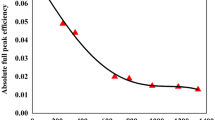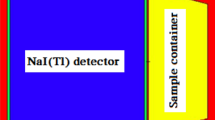Abstract
The radiological hazard associated with the buildings of Nueva Rosita (northeastern Mexico) was assessed by gamma spectrometry measurements. Using a Handheld Gamma-Ray Spectrometer, the potassium, uranium, and thorium concentrations were measured. Also, four radiological indices are calculated: the absorbed dose rate (D), the annual effective dose equivalent (E), the hazard index (H), and the excess lifetime cancer risk (ELCR). Inside and outside of public buildings and dwellings, urban space gamma-ray measurements were carried out. According to the year they were built, the public buildings and dwellings of Nueva Rosita were classified into three groups (new, moderately old, and old buildings). Using the activity concentration of radioelements and calculated radiological hazard indices, the studied environments were classified into three classes of radiological hazards. This last classification was carried out by comparing the values of radionuclides and indices with world averages. Class 1 characterizes the environments with a low radiological hazard, class 2, the environments with a moderate radiological hazard, and class 3, the environments with a high radiological hazard. The highest hazard is located indoors in buildings and the lowest hazard occurs in urban spaces. The old buildings have the highest hazard both indoors and outdoors, due to the high content of uranium (102–111 Bq kg−1) and thorium (70–144 Bq kg−1) and the values of D (84–261 nGy h−1), E (0.1–1.28 mSv y−1), H (0.5–1.09), and ELCR (0.35–4.48 × 10–3) that can exceed up to four times their world average.









Similar content being viewed by others
References
Abdel-Halim AA, Saleh IH (2016) Radiological characterization of beach sediments along the Alexandria–Rosetta coasts of Egypt. J Taibah Univ Sci 10:212–220. https://doi.org/10.1016/j.jtusci.2015.02.016
Al-Ghamdi AH (2019) Health risk assessment of natural background radiation in the soil of Eastern province, Saudi Arabia. J Radiat Res Appl Sci 12:219–225. https://doi.org/10.1080/16878507.2019.1637045
Amanjeet KA, Kumar S, Singh J, Singh P, Bajwa BS (2017) Assessment of natural radioactivity levels and associated dose rates in soil samples from historical city Panipat, India. J Radiat Res Appl Sci 10:283–288. https://doi.org/10.1016/j.jrras.2017.05.006
Asaduzzaman K, Mannan F, Khandaker MU, Farook MS, Elkezza A, Amin YB, Sharma S, Abu Kassim HB (2015) Assessment of natural radioactivity levels and potential radiological risks of common building materials used in Bangladeshi dwellings. PLoS ONE 10(10):e0140667. https://doi.org/10.1371/journal.pone.0140667
Asokan P, Saxena M, Asolekar SR (2005) Coal combustion residues—environmental implications and recycling potentials. Resour Conserv Recycl 43:239–262. https://doi.org/10.1016/j.resconrec.2004.06.003
Batista-Rodríguez JA, Rodríguez EN, Rodríguez-Riojas PA, Díaz-Martínez R, Rodríguez-Vega A, López-Saucedo F (2020) In situ magnetic susceptibility and gamma radiation data in the Candela-Monclova intrusive belt, Northeast Mexico: case studies of the Cerro Colorado and Cerro Marcelinos plutons. Turk J Earth Sci 29:579–595. https://doi.org/10.3906/yer-1905-21
Batista-Rodríguez JA, Proenza-Fernández JA, Rodríguez-Vega A, López-Saucedo F, Cázares-Carreón KI (2017) Magnetic susceptibility and natural gamma radioactivity as indirect proxies for characterization of sandstones and limestones of the Sabinas Basin. Geofizika 34:19–42. https://doi.org/10.15233/gfz.2017.34.6
Baykara O, Karatepe S, Doğru M (2011) Assessments of natural radioactivity and radiological hazards in construction materials used in Elazig, Turkey. Radiat Meas 46:153–158. https://doi.org/10.1016/j.radmeas.2010.08.010
Chambers DB (2013) Radiological protection in North American naturally occurring radioactive material industries. International Commission on Radiological Protection. Annual Report. 202–2013. https://doi.org/10.1177/0146645315572300
Corona-Esquivel R, Tritilla J, Benavides ME, Piedad-Sanchez N, Ferrusquía I (2006) Geología, estructura y composición de los principales yacimientos de carbón mineral en México. Bol Soc Geol Mex 57:141–160. https://doi.org/10.18268/bsgm2006v58n1a5
Eguiluz de Antuñan S (2001) Geologic evolution and gas resources of the Sabinas Basin in Northeastern Mexico. In: Bartolini C, Buffler RT, Cantú-Chapa A (eds) The western Gulf of Mexico Basin: Tectonics, sedimentary basins, and petroleum systems. AAPG Mem 75:241–270. https://doi.org/10.1306/M75768C10
European Commission EC (1999) Radiation Protection 112. Radiological protection principles concerning the natural radioactivity of building materials. Directorate General Environment, Nuclear Safety and Civil Protection. https://ec.europa.eu/energy/sites/ener/files/documents/112.pdf. Accessed 13 May 2021
González-Sánchez F, Puente-Solís R, González-Partida E, Camprubí A (2007) Estratigrafía del Noreste de México y su relación con los yacimientos estratoligados de fluorita, barita, celestina y Zn-Pb. Bol Soc Geol Mex 59:43–62. https://doi.org/10.18268/bsgm2007v59n1a4
Gupta M, Chauhan RP (2011) Estimating radiation dose from building materials. Iran J Radiat Res 9:187–194
International Atomic Energy Agency, IAEA (1989) Construction and Use of Calibration Facilities for Radiometric Field Equipment. Technical Reports Series No. 309, IAEA, Vienna, Austria
Inoue K, Tsuruoka H, Shimizu H, Arai M, Veerasamy N, Tsukada M, Ichimura K, Nakazawa S, Taguchi Y, Fukushi M (2019) Changes of absorbed dose rate in air in metropolitan Tokyo relating to radiocesium released from the Fukushima Daiichi Nuclear Power Plant accident: results of a five-year study. PLoS ONE 14(10):e0224449. https://doi.org/10.1371/journal.pone.0224449
Inoue K, Fukushi M, Van Le T, Tsuruoka H, Kasahara S, Nimelan V (2020) Distribution of gamma radiation dose rate related with natural radionuclides in all of Vietnam and radiological risk assessment of the built-up environment. Sci Rep 10:12428. https://doi.org/10.1038/s41598-020-69003-0
International Atomic Energy Agency, IAEA (2003) Guidelines for Radioelement Mapping Using Gamma Ray Spectrometry Data, IAEA-TECDOC-1363, IAEA, Vienna, Austria. https://www-pub.iaea.org/mtcd/publications/pdf/te_1363_web.pdf. Accessed 13 May 2021.
Khandaker MU, Jojo PJ, Kassim HA, Amin YM (2012) Radiometric analysis of construction materials using HPGe gamma-ray spectrometry. Radiat Prot Dosimetry 152:33–37. https://doi.org/10.1093/rpd/ncs145
Kumara PARP, Mahakumara P, Jayalath A, Jayalath CP (2018) Estimating natural radiation exposure from building materials used in Sri Lanka. J Radiat Res Appl Sci 11:350–354. https://doi.org/10.1016/j.jrras.2018.07.001
Lauer NE, Hower JC, Hsu-Kim H, Taggart RK, Vengosh A (2015) Naturally occurring radioactive materials in coals and coal combustion residuals in the United States. Environ Sci Technol 49:11227–11233. https://doi.org/10.1021/acs.est.5b01978
Lima M, Sanjurjo-Sánchez J, Alves C (2017) Assessment by portable gamma spectrometry of external gamma radiation hazard due to granitic materials and indoor pace typology. Geosciences 7(4):131. https://doi.org/10.3390/geosciences7040131
Mota-Ortíz JL (2017) Radioactividad Gamma Natural y Riesgo Radiológico en Construcciones de Nueva Rosita. Bachelor’s Thesis, Autonomous University of Coahuila, Mexico
Nowak K, Solecki A (2015) Factors affecting background gamma radiation in the urban space. J Elem 20:653–665. https://doi.org/10.5601/jelem.2014.19.4.755
Qureshi AA, Tariq S, Din K, Manzoor S, Calligaris S, Waheed A (2014) Evaluation of excessive lifetime cancer risk due to natural radioactivity in the rivers sediments of Northern Pakistan. J Radiat Res Appl Sci 7:438–447. https://doi.org/10.1016/j.jrras.2014.07.008
Raghu Y, Ravisankar R, Chandrasekaran A, Vijayagopal P, Venkatraman B (2017) Assessment of natural radioactivity and radiological hazards in building materials used in the Tiruvannamalai District, Tamilnadu, India, using a statistical approach. J Taibah Univ Sci 11:523–533. https://doi.org/10.1016/j.jtusci.2015.08.004
Ramasamy V, Sundarrajan M, Paramasivam K, Meenakshisundaram V, Suresh G (2013) Assessment of spatial distribution and radiological hazardous nature of radionuclides in high background radiation area, Kerala, India. Appl Radiat Isot 73:21–31. https://doi.org/10.1016/j.apradiso.2012.11.014
Radiation Solution Inc (2015) RS-125/230 User Manual. Revision 1.05—December 2015. https://www.aseg.org.au/sites/default/files/RS-125%20RS-230_User_Manual%20%28GR%29.pdf
Secretaría de Energía, SE (2000) NOM-035-NUCL-2000. Límites para considerar un residuo sólido como desecho radiactivo. Diario Oficial de la Federación. http://www.dof.gob.mx/nota_detalle.php?codigo=2055057&fecha=19/05/2000. Accessed 03 June 2021.
Secretaría de Energía, SE (2013) NOM-004-NUCL-2013, Clasificación de los desechos radiactivos. Diario Oficial de la Federación. https://www.dof.gob.mx/nota_detalle.php?codigo=5298125&fecha=07/05/2013. Accessed 03 June 2021
Servicio Geológico Mexicano, SGM (2003) Carta geológico-minera Nueva Rosita Coahuila G14-13: Cartas geológicas de México serie 1: 50,000, 1 mapa con texto
Shoeib MY, Thabayneh KM (2014) Assessment of natural radiation exposure at radon exhalation rate in various samples of Egyptian building materials. J Radiat Res Appl Sci 7:174–181. https://doi.org/10.1016/j.jrras.2014.01.004
Siegesmund SF, Friedel CH, Vogel J, Mosch S, Naumann D, Peter A, Giesen H (2011) Stability assessment of sand stones from the St. Servatus Church in Quedlinbung (UNESCO’s World Heritage Site Germany). Environ Earth Sci 63:641–659. https://doi.org/10.1007/s12665-010-0736-7
Stück H, Siegesmund S, Rüdrich J (2011) Weathering behaviour and construction suitability of dimension stones from the Drei Gleichen area (Thuringia, Germany). Environ Earth Sci 63:1763–1786. https://doi.org/10.1007/s12665-011-1043-7
Svoukis E, Tsertos H (2007) Indoor and outdoor in situ high-resolution gamma radiation measurements in urban areas of Cyprus. Radiat Prot Dosimetry 123:384–390. https://doi.org/10.1093/rpd/ncl159
Taskin H, Karavus M, Ay P, Topuzoglu A, Hindiroglu S, Karahan G (2009) Radionuclide concentrations in soil and lifetime cancer risk due to gamma radioactivity in Kirklareli, Turkey. J Environ Radioact 100:49–53. https://doi.org/10.1016/j.jenvrad.2008.10.012
Todorovic N, Bikit I, Krmar M, Mrdja D, Hansman J, Nikolov J, Forkapic S, Veskovic M, Bikit K, Jakonic I (2015) Natural radioactivity in raw materials used in building industry in Serbia. Int J Environ Sci Technol 12:705–716. https://doi.org/10.1007/s13762-013-0470-2
United Nations Scientific Committee on the Effects of Atomic Radiation, UNSCEAR (1988) Sources, Effects and Risks of Ionizing Radiation, United Nations, New York.
United Nations Scientific Committee on the Effects of Atomic Radiation, UNSCEAR (2000) Sources and Effects of Ionizing Radiation. Report to the General Assembly, with scientific annexes, Vol. I, United Nations, New York
Wang N, Xiao L, Li C, Huang Y, Pei S, Liu S, Xie F, Cheng Y (2005) Determination of radioactivity Level of 238U, 232Th and 40K in surface medium in Zhuhai city by in-situ gamma-ray spectrometry. J Nucl Sci Technol 42:888–896. https://doi.org/10.1080/18811248.2005.9711040
Acknowledgements
We thank the Autonomous University of Coahuila and particularly the Higher School of Engineering for their support of this research.
Funding
The authors received no specific funding for this work.
Author information
Authors and Affiliations
Contributions
All authors contributed equally to the work.
Corresponding author
Ethics declarations
Conflict of interest
The authors declare that they have no conflict of interest.
Additional information
Editorial Responsibility: Chenxi Li.
Rights and permissions
About this article
Cite this article
Batista-Rodríguez, J.A., López-Saucedo, F.J., Almaguer-Carmenates, Y. et al. Assessment by portable gamma spectrometry of the radiological hazard associated with built environments in northeastern Mexico. Int. J. Environ. Sci. Technol. 19, 8645–8660 (2022). https://doi.org/10.1007/s13762-021-03737-w
Received:
Revised:
Accepted:
Published:
Issue Date:
DOI: https://doi.org/10.1007/s13762-021-03737-w




